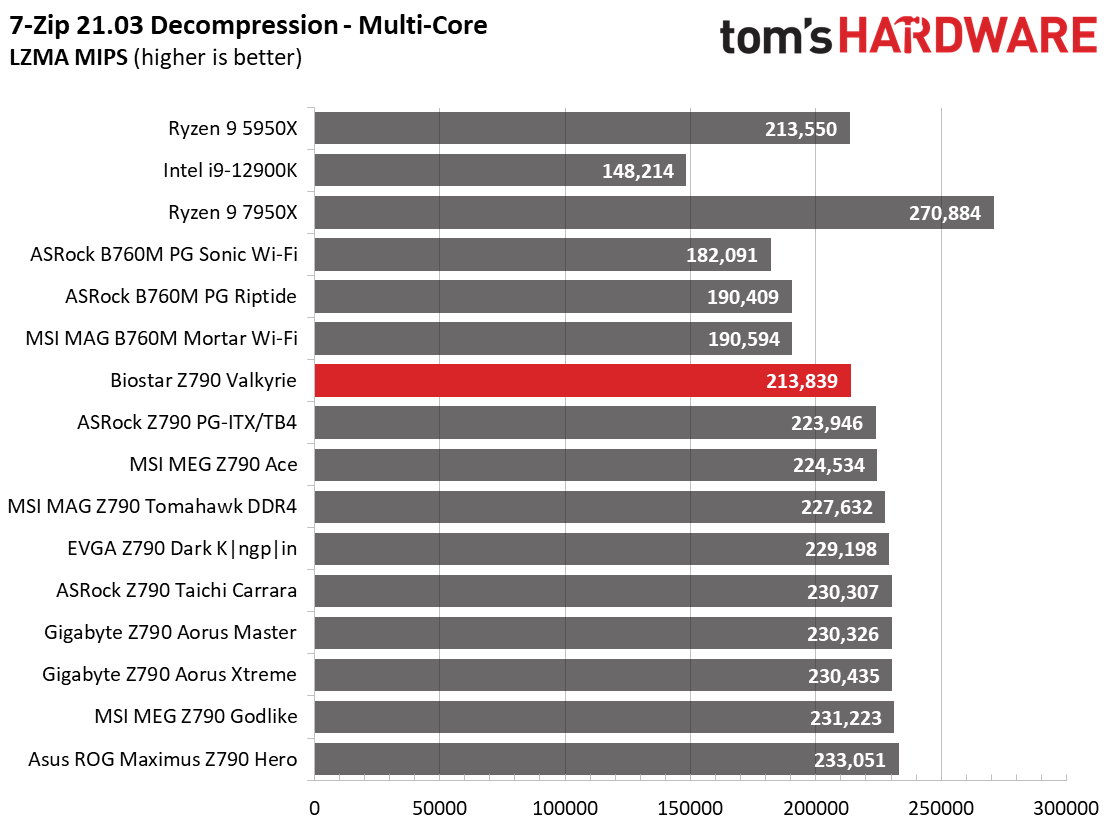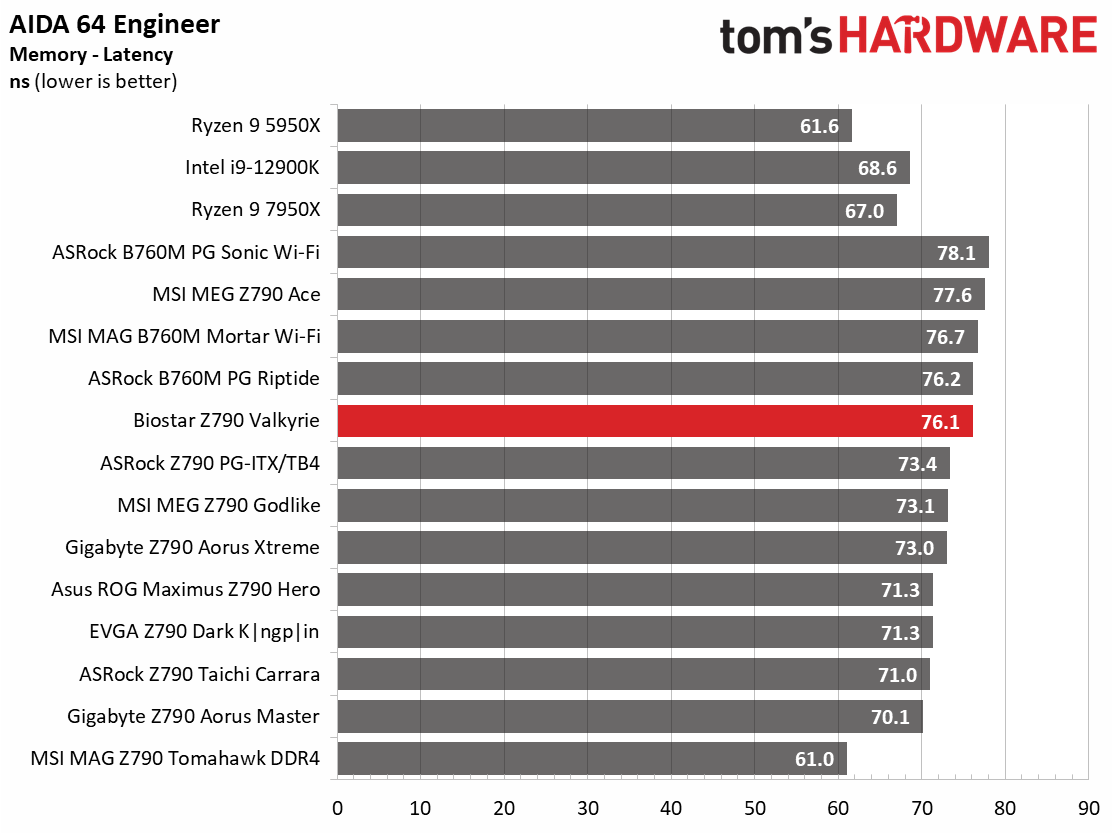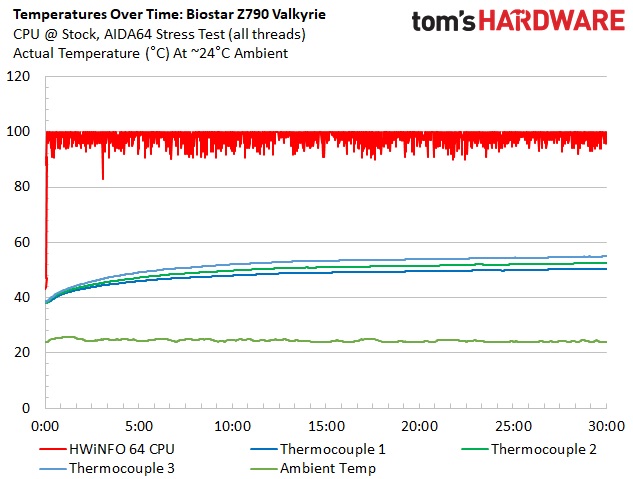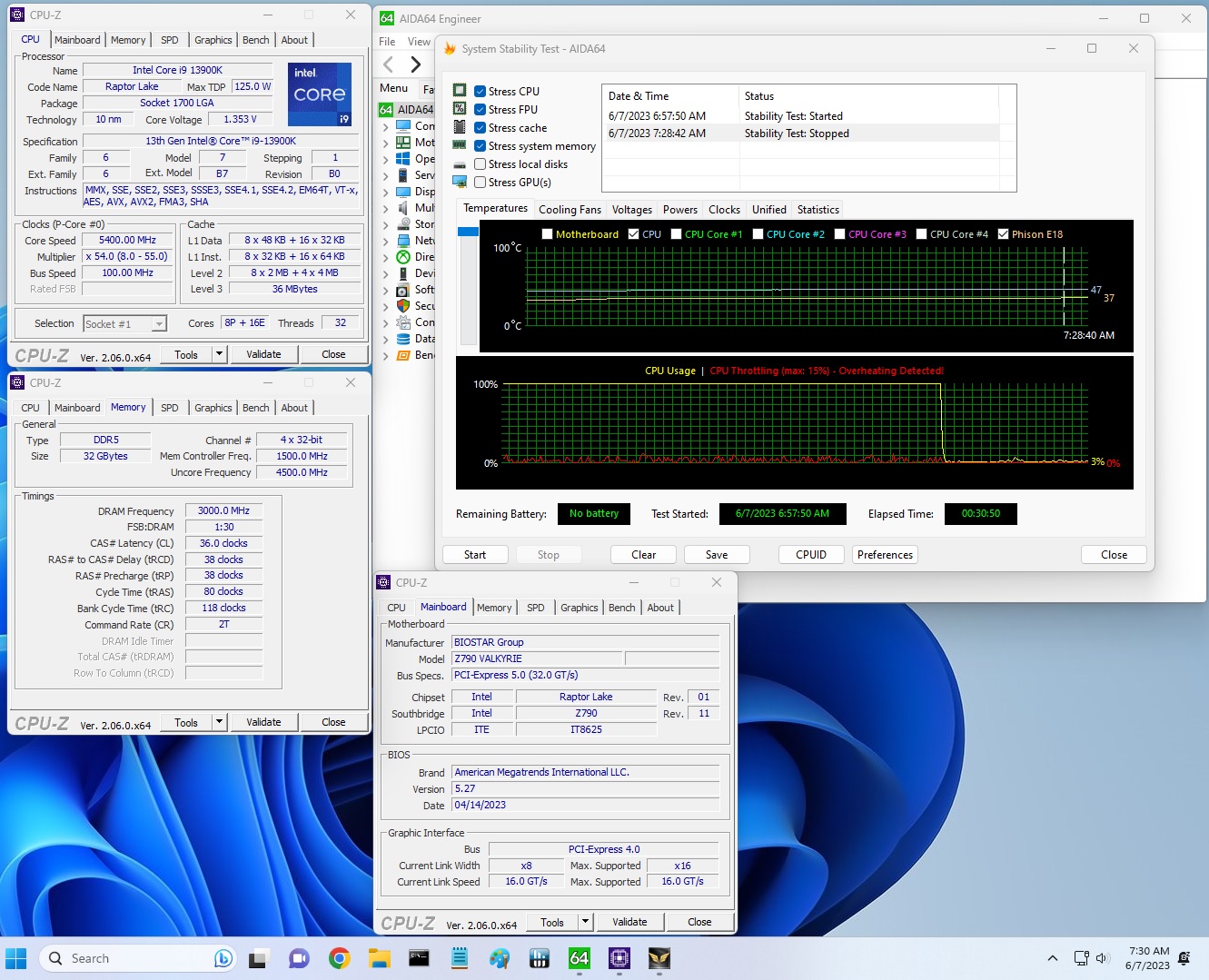Why you can trust Tom's Hardware
Benchmark Results
Our standard benchmarks and power tests are performed using the CPU’s stock frequencies (including any default boost/turbo), with all power-saving features enabled. We set optimized defaults in the BIOS and the memory by enabling the XMP profile. For this baseline testing, the Windows power scheme is set to Balanced (default) so the PC idles appropriately.
Synthetic Benchmarks
Synthetics provide a great way to determine how a board runs, as identical settings should produce similar performance results. Turbo boost wattage and advanced memory timings are places where motherboard makers can still optimize for either stability or performance, though, and those settings can impact some testing.
















In our synthetic tests, our Z790 Valkyrie was average to below average, depending on the test. In all, it sits between the intel spec and other high-end boards where (at least) the PL1 limit is increased to maintain clocks. Like most boards, ours is plagued with thermal throttling in some tests, affecting the scores. The difference isn’t too significant, but it’s not one of the higher-performing boards we’ve tested.
Timed Applications




When looking at our timed applications, the LAME and Corona results were both slower than average. Meanwhile, both Handbrake tests were some of the fastest we’ve seen.
3D Games and 3DMark




Starting with the launch of Zen 4, we’ve updated one of our games, F1 21, to the latest version, F1 22. We're keeping Far Cry 6. We run the games at 1920 x 1080 resolution using the Ultra preset (details listed above). As the resolution goes up, the CPU tends to have less impact. The goal with these settings is to determine if there are differences in performance at the most commonly used (and CPU/system bound) resolution with settings most people use or strive for (Ultra). We expect the difference between boards in these tests to be minor, with most differences falling within the margin of error. We’ve also added a minimum FPS value, as this affects your gameplay and immersion experience.
Starting with the UL’s 3DMark tests, our board mixed right in with the rest. In games, it was average in F1 2022, and just slightly below average in Far Cry: 6. That said, you wouldn’t notice a difference between this and the fastest results unless you had a frame counter on the screen anyway. It’s a perfectly competent gamer.
Power Consumption / VRM Temperatures
We used AIDA64’s System Stability Test with Stress CPU, FPU, Cache and Memory enabled for power testing, using the peak power consumption value. The wattage reading is from the wall via a Kill-A-Watt meter to capture the entire PC (minus the monitor). The only variable that changes is the motherboard; all other parts remain the same.
Get Tom's Hardware's best news and in-depth reviews, straight to your inbox.
Power consumption on the Z790 Valkyrie was just below average, using a bit more power than most of our boards. It averaged 72 Watts at idle and peaked at 402W during the stress-test load before it thermally throttled and used less power (from around 253 to 230W on the CPU itself).


VRM temperatures on the Valkyrie was also well within specification. At stock, temperatures, according to our sensors (the board doesn’t have an internal VRM sensor), were well within the operating parameters of the premium 105A SPS MOSFETs at stock settings and while overclocked. At idle, they sat close to 40 degrees Celsius, while it peaked around 54 degrees Celsius under load. There’s nothing to be concerned with regarding the power delivery or its cooling, as your CPU temperatures limit you before the VRMs get in the way.
Overclocking
When overclocking, we aim to increase the power and add stress to the VRMs. We do so by increasing the clock speed and voltage until we’re at the thermal threshold for the processor during stress testing. However, where these CPUs are allowed to run with ‘boost’ speeds, those speeds are closer to the limit than ever before.
With our Core i9-13900K, the approach was a bit different. We had to lower the voltage from what was recorded during stress tests to overclock our chip. We increased the clock speeds of the “P” and “E” cores by 100 and 200 MHz, respectively, over the turbo boost and limited by our cooling. We ended up with 5.6 GHz P-core and 4.5 GHz E-core clocks using about 1.34V (from DMM). Temperatures peak at or just under the throttling point with this configuration. And as we’ve noted elsewhere, this is the intended performance for Intel’s flagship CPU.
Overclocking our processor proved as easy as most other Z790 boards. We set the Vcore to Override input 1.35V with LLC on Auto, and off we went. There wasn’t any appreciable vdroop, and testing went well. The VRMs stayed well within spec, and we were stable throughout our 30-minute test.
Regarding memory, our 5600 and 6000 kits worked out of the box without issue. Compared to the X670E we looked at a few months ago, this is great news but also expected since this review is several months past the release date, so the platform and BIOS has had time to mature. Overall, we didn’t run into any concerns when overclocking. Still, again, if you aim to run the fastest memory and/or tweak secondary and tertiary memory timings, there are better-equipped options.
Bottom Line
The Biostar Z790 Valkyrie is a well-equipped board in the premium mid-range segment. While it doesn’t include 40 Gbps ports, it’s got everything else the platform offers, including PCIe 5.0 slots and a PCIe 5.0 M.2 socket. Outside of that, it comes with one of the more robust VRMs we’ve seen, even when compared to halo-type boards. You’re limited by cooling far before the power delivery hinders overclocking. Performance was underwhelming across most tests, running slightly slower than average in most, but the board proved to be a capable gaming machine.
Biostar’s MSRP for our board is somewhere around $450. However, you’ll find it online in the US for well over $600, which pushes it into even tougher territory. Around the $500 price point, each partner has an option. There’s the MSI’s MPG Z790 Carbon Wi-Fi ($449.99), Asus’ ROG Strix Z790-E Gaming Wi-Fi ($489.99), Gigabyte has its Z790 Aorus Master ($489.99), and the ASRock Z790 Taichi is $499.99. All of these boards offer robust power delivery, fast memory support, up to five M.2 sockets, and a premium appearance. If you need 40 Gbps ports, the Taichi is the only one of the group with that native functionality. All of the compeitng BIOSes are more refined than Biostar’s as well.
Assuming you can find the Z790 Valkyrie around the $450 MSRP, it’s a valid option in this space. But if it costs more than $500, it’s not worth it. We’ve seen some improvements over time with Biostar, but in order to compete with the major motherboard players and justify a high price, some things need to change. A more modern BIOS layout and better physical appearance (read: one that looks as good versus its direct competitors) are key, as we’re good with the specifications. As it stands, there are better-equipped and arguably more attractive options available at lower prices than what this board is selling for in the US.
MORE: Best Motherboards
MORE: How To Choose A Motherboard
MORE: All Motherboard Content

Joe Shields is a staff writer at Tom’s Hardware. He reviews motherboards and PC components.


